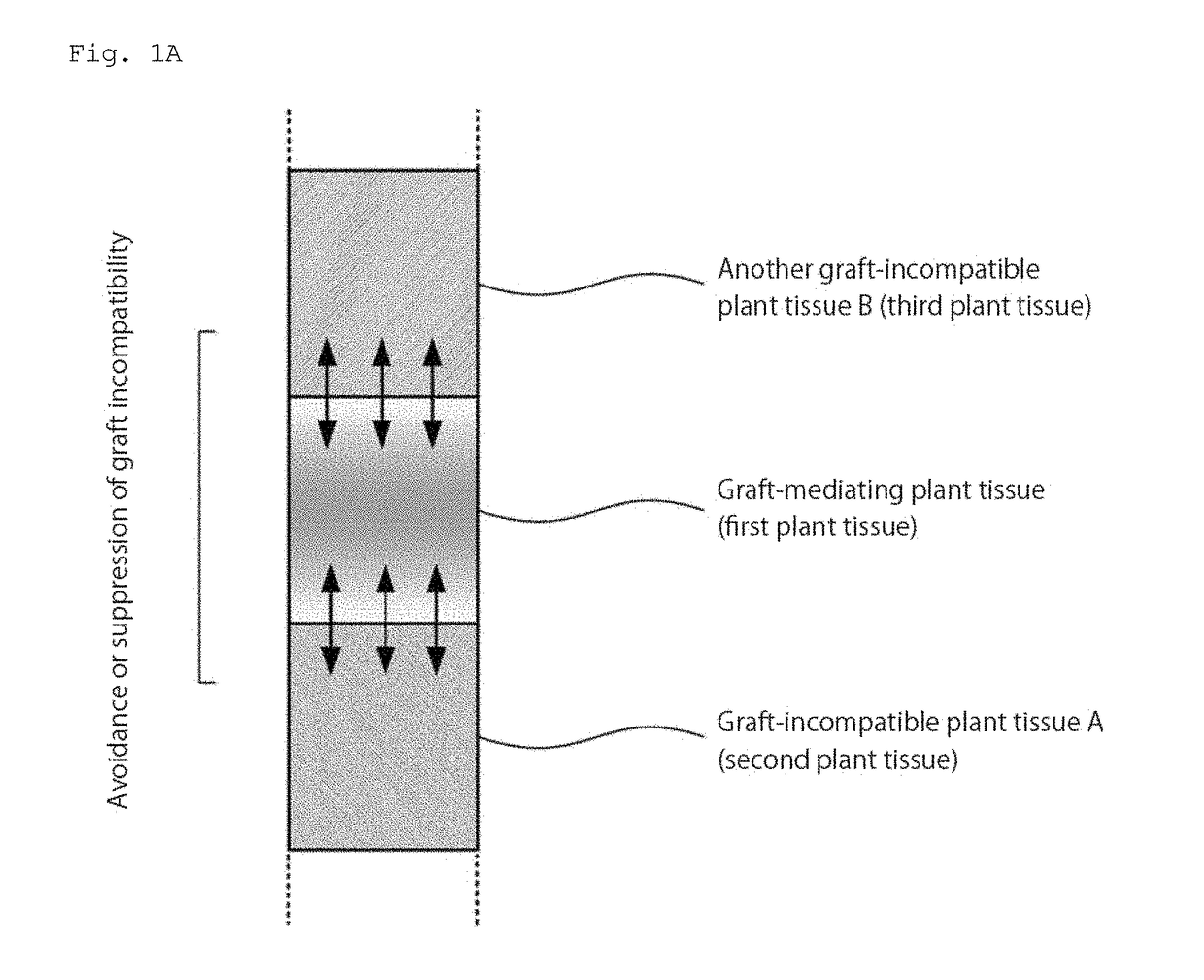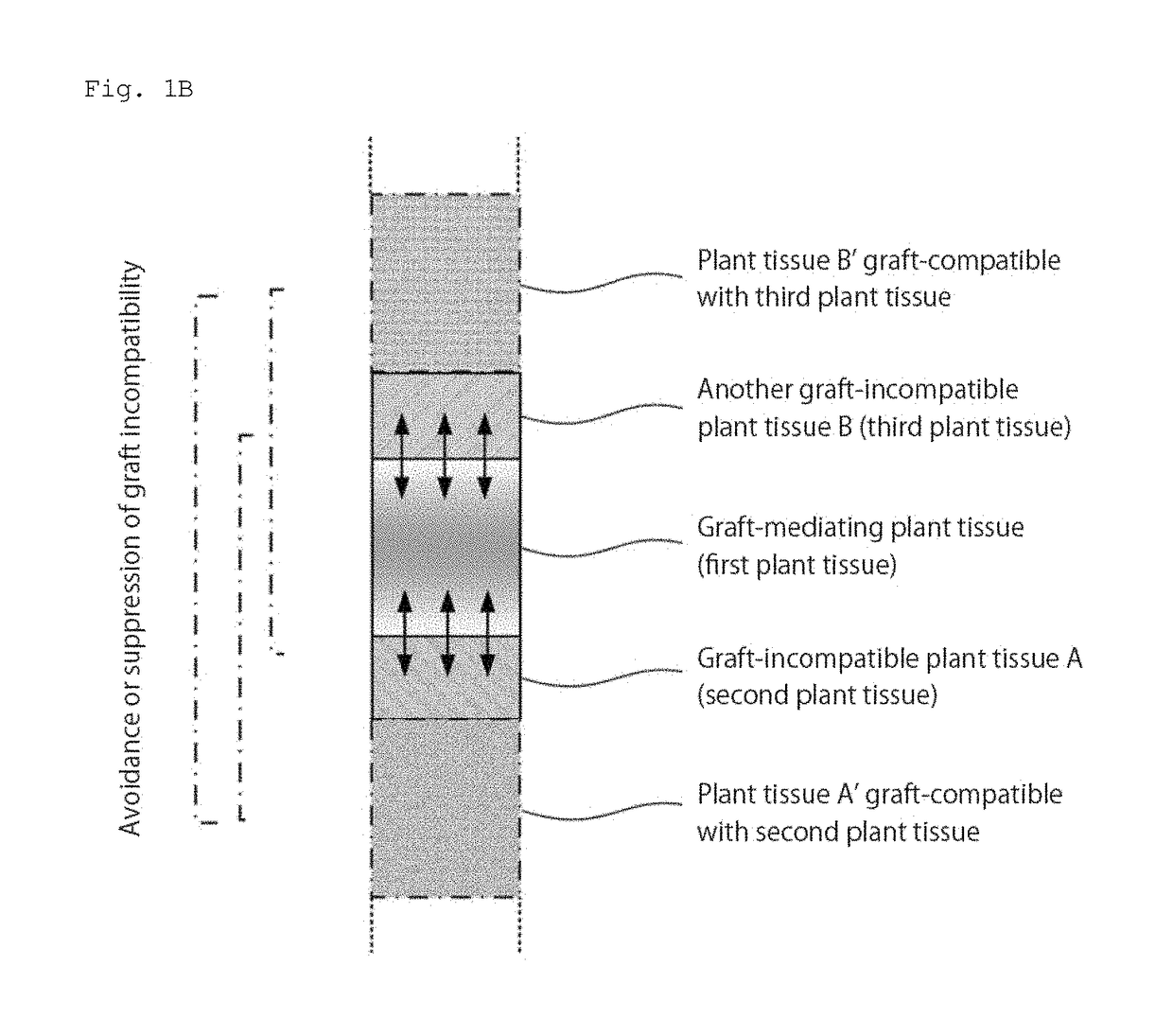Grafted plant body and method for producing same
a plant body and plant technology, applied in the field of grafted plant body and a method for producing the same, can solve the problems that grafting is generally considered inability to be completed between different-family plants, and achieve the effect of avoiding or suppressing graft incompatibility and high degree of freedom
- Summary
- Abstract
- Description
- Claims
- Application Information
AI Technical Summary
Benefits of technology
Problems solved by technology
Method used
Image
Examples
example 1
Production of Two-Species Grafted Plant Body
[0149]Plants grown in a greenhouse or an artificial weather device using compost were used for grafting. For Nicotiana benthamiana, individuals within one to two months after seeding were used, and for other plants, buds or plant seedlings grown for several weeks to several years were used. Grafting (cleft grafting) was applied to a stem or petiole. A stock was prepared by horizontally cutting a stem or petiole, and making incisions of about 1 to 2 cm in the center of the cut surface. When grafting was applied to a stem, regions between knots were used as much as possible. In addition, when cleft grafting was performed at the position of a stem knot, a stock was prepared by making incisions of about 1 to 2 cm so as to divide between the main stem and a lateral branch or petiole. A scion was prepared by cutting a stem to separate an upper portion, and further cutting the cut end in a V shape so as to fit with the stock. A series of cuts wer...
example 2
Production of Two-Species Grafted Plant Body Using Interstock
[0151]Grafting by the interstock method comprises a stock, an interstock, and a scion. Therefore, grafting was performed between a stock and an interstock, and between an interstock and a scion. When grafting was performed in two places at the same time, first, the stem (including about two knots) of a plant used as an interstock was cut, and a scion was assembled at the tip of the stem in the originally growing direction. Subsequently, the end of the stem of the interstock / scion on the interstock side was assembled to the stem of a stock. When grafting was performed in two places on different days in two steps, first, grafting was performed between a plant as a stock and a plant as an interstock. Then, the state of graft was confirmed to be good at the first or second week after grafting, and a scion was grafted on the plant as an interstock.
[0152]Alternatively, grafting was performed independently between a plant as a st...
example 3
Confirmation of Apoplastic Transport
[0154]The tests of Examples 3 to 9 were conducted on grafting between a Nicotiana benthamiana scion and an Arabidopsis thaliana stock at the third week after grafting. A flower stalk of the stock was horizontally cut near the root to cut off the scion together with the flower stalk of the stock. 2 or 3 longitudinal incisions were made on the cut surface on the stock side, and the cut stem was placed in a 0.5% toluidine blue aqueous solution dispensed in a 1.5-mL tube to allow the stem to absorb the solution. 3 to 6 hours later, longitudinal or traverse free-hand sections of the graft connection, and the stem (a region close to the graft site) of the scion were produced. Then, it was confirmed and photographed using a stereoscopic microscope or an optical microscope that the blue color of the toluidine blue reagent was observed in vessel elements on the scion side. FIG. 4 shows the results. Of FIG. 4, A shows a schematic diagram of grafting, and B ...
PUM
 Login to View More
Login to View More Abstract
Description
Claims
Application Information
 Login to View More
Login to View More - R&D
- Intellectual Property
- Life Sciences
- Materials
- Tech Scout
- Unparalleled Data Quality
- Higher Quality Content
- 60% Fewer Hallucinations
Browse by: Latest US Patents, China's latest patents, Technical Efficacy Thesaurus, Application Domain, Technology Topic, Popular Technical Reports.
© 2025 PatSnap. All rights reserved.Legal|Privacy policy|Modern Slavery Act Transparency Statement|Sitemap|About US| Contact US: help@patsnap.com



